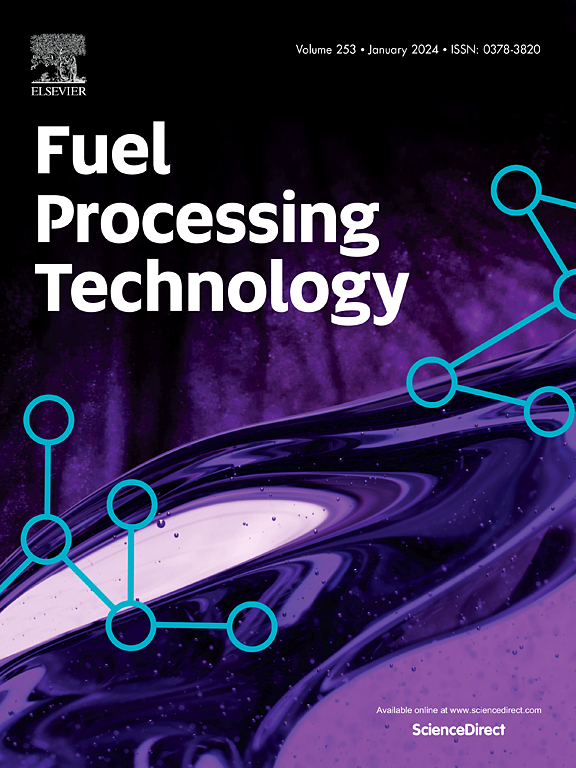定日镜与抛物面槽集热器集成及燃烧后碳捕获优化配置用于蒸汽甲烷重整的热经济可行性
IF 7.2
2区 工程技术
Q1 CHEMISTRY, APPLIED
引用次数: 0
摘要
在使用蒸汽甲烷重整(SMR)的制氢工厂中集成碳捕获装置可以显著减少排放,但需要高能量投入。本研究调查了在伊朗德黑兰使用太阳能热能为燃烧后碳捕获(PCC)系统供电。在Aspen HYSYS 11中进行模拟,评估配置以优化SMR烟气中的CO₂捕获,重点是最大限度地减少再锅炉的能源需求。最优的PCC模型需要71.5 MW的热能,由Thermoflex模拟的太阳能发电厂提供。对抛物面槽式集热器(PTC)和太阳能塔进行了评估,分别需要0.87平方公里和1.91平方公里的建设面积。SAM软件中的季节和日常性能分析显示,太阳能倍数(SM)为3.5的PTC系统实现了80%的容量因子(CF)和5.60的平均热成本(LCOH)。该太阳能塔系统的SM为3,CF为90%,LCOH为7.08。运行经济性分析表明,PTC系统运行经济性因子为24.51%,太阳能塔运行经济性因子为31.45%。这些发现证明了太阳能辅助PCC系统在提高smr制氢可持续性方面的潜力。本文章由计算机程序翻译,如有差异,请以英文原文为准。
Thermo-economic feasibility of heliostat and parabolic trough collector integration with optimized configuration of post-combustion carbon capture for steam methane reforming
Integrating carbon capture units in hydrogen production plants using steam methane reforming (SMR) can significantly reduce emissions but requires high energy inputs. This study investigates using solar thermal energy to power post-combustion carbon capture (PCC) systems in Tehran, Iran. Simulations in Aspen HYSYS 11 evaluate configurations to optimize CO₂ capture from SMR flue gases, focusing on minimizing reboiler energy demands. The optimal PCC model requires 71.5 MW of thermal energy, supplied by solar power plants simulated in Thermoflex. Parabolic trough collectors (PTC) and solar towers are assessed, requiring 0.87 km2 and 1.91 km2, respectively, for construction. Seasonal and daily performance analysis in SAM software reveals that the PTC system, with a solar multiple (SM) of 3.5, achieves an 80 % capacity factor (CF) and a levelized cost of heat (LCOH) of 5.60. The solar tower system, with an SM of 3, achieves a 90 % CF and an LCOH of 7.08. Exergoeconomic analysis indicates exergoeconomic factors of 24.51 % for the PTC system and 31.45 % for the solar tower. These findings demonstrate the potential of solar-assisted PCC systems to enhance sustainability in SMR-based hydrogen production.
求助全文
通过发布文献求助,成功后即可免费获取论文全文。
去求助
来源期刊

Fuel Processing Technology
工程技术-工程:化工
CiteScore
13.20
自引率
9.30%
发文量
398
审稿时长
26 days
期刊介绍:
Fuel Processing Technology (FPT) deals with the scientific and technological aspects of converting fossil and renewable resources to clean fuels, value-added chemicals, fuel-related advanced carbon materials and by-products. In addition to the traditional non-nuclear fossil fuels, biomass and wastes, papers on the integration of renewables such as solar and wind energy and energy storage into the fuel processing processes, as well as papers on the production and conversion of non-carbon-containing fuels such as hydrogen and ammonia, are also welcome. While chemical conversion is emphasized, papers on advanced physical conversion processes are also considered for publication in FPT. Papers on the fundamental aspects of fuel structure and properties will also be considered.
 求助内容:
求助内容: 应助结果提醒方式:
应助结果提醒方式:


